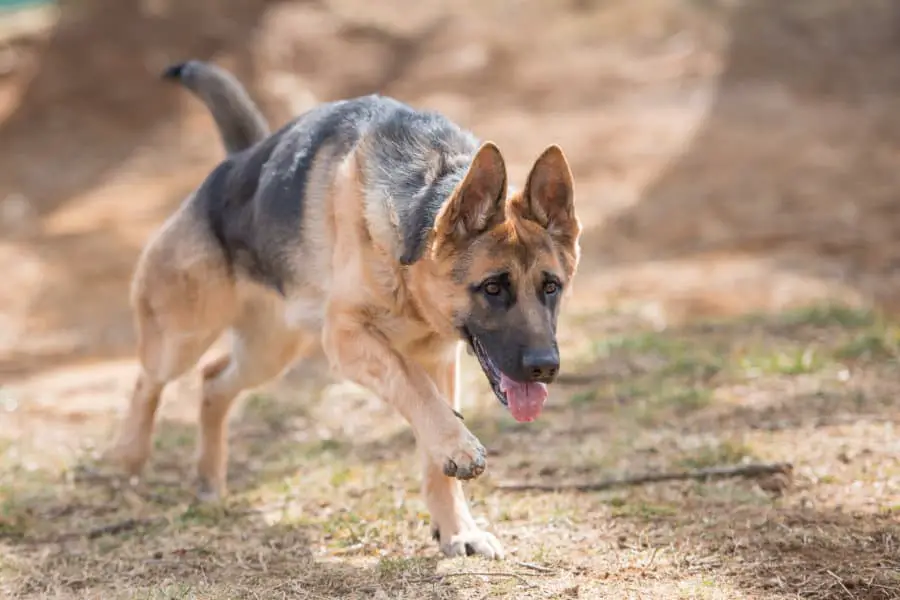German Shepherds are strong, loyal, intelligent, and majestic pets. Therefore, it’s understandable to be concerned when your German Shepherd starts limping. Unfortunately, limping is a common issue in German Shepherds due to the fact that this breed is susceptible to multiple conditions that cause lameness.
Your German Shepherd could be limping for several reasons like injuries, arthritis, Lyme disease, panosteitis, and canine hip dysplasia. While minor injuries and arthritis are common in most breeds, panosteitis and canine hip dysplasia are unique to German Shepherds and other large breeds.
This article will describe common causes and signs of lameness in your German Shepherd and what to do if you notice that your dog is limping.

General Information on Limping
Limping (also known as lameness) can be caused by various injuries or underlying conditions. For German Shepherds, it’s common due to abnormal anatomy or common health issues.
Depending on the cause, the condition can affect just one or multiple legs. Your dog’s limping may be temporary, come and go, or it may be long-term. You may also only notice limping during certain times of the day or after certain activities, such as exercising or resting.
Dogs often hide their injuries and illnesses from their owners. Therefore, your dog’s lameness may not be obvious. Here are some signs to watch out for:
- Refuses to put weight on one leg
- Unable to walk or run normally
- Shows sign of pain or discomfort
- Walks slowly
- Has difficulty walking up the stairs or jumping into a car or on a couch
- Can’t put a paw on the floor properly
- Has swelling around the joints in the leg
Reasons Why German Shepherds Limp
Injuries
The most likely reason why your German Shepherd is limping is that he injured his leg or paw, most likely during rough play or exploration. Common injuries include:
- Bone break or fracture
- Torn, pulled, or strained muscle
- Slipped disc
- Torn or damaged ligament
- Cut or wound on the paw or leg
If a minor cut or injury is making your dog limp, you can treat it at home. However, if you see any signs of a broken bone, fracture, or something worse, you should take your pup to the vet.
Arthritis
Like all elderly animals, German Shepherds are susceptible to arthritis, and they tend to gradually lose their ability to walk.
How can you be sure your German Shepherd has arthritis?
Dogs with arthritis are typically in the most pain just after rest. If your German Shepherd is limping or having trouble moving after resting but improves with a bit of exercise, then they may be suffering from arthritis.
Moreover, arthritis worsens in cold or damp weather. So, keep an eye on your dog on warmer days and see if the limping improves.
It’s best to ask your vet to make a definite diagnosis and give you suggestions on how to relieve your German Shepherd’s pain.
Lyme Disease
Many people don’t realize that Lyme disease can also cause lameness in dogs. Lyme disease is caused by Borrelia burgdorferi bacteria and is transmitted through tick bites. However, infections usually only occur if the tick has been attached to your dog for more than 24 hours. Therefore, it’s essential to check your dog for ticks often to prevent your dog from contracting Lyme disease.
Dominant symptoms of Lyme disease include lameness, fever, and general malaise. However, in some cases, other symptoms can include:
- Depression
- Swollen, warm, or painful joints
- Loss of appetite
- Difficulty breathing
- Sensitivity to touch
Lameness due to Lyme disease usually lasts a few days. However, there can be recurring episodes every few weeks, so you will still want to take your German Shepherd to the vet for diagnosis.
It’s important to note that not all dogs who get Lyme disease show any symptoms. Furthermore, it can lead to serious problems with the dog’s kidneys, heart, and nervous system when it goes unchecked. Therefore, you should get your dog checked for Lyme disease even if they are not showing any symptoms.
Your vet will be able to diagnose your dog for Lyme disease through blood tests, X-rays, and urinalysis.

Panosteitis
Panosteitis refers to a painful bone inflammation with an unknown cause that affects the long bone in a dog’s legs. This condition is common among young dogs (5-18 months) of medium to large-sized breeds, mainly German Shepherds. It usually affects the front legs but can affect the back legs as well.
Therefore, if your dog is young and struggles to walk on its front legs, you should take it to your vet, to rule out a serious illness.
Your dog may be in pain for a few days or a few months, but the condition eventually gets better on its own. Unfortunately, there’s no cure for panosteitis, nor is there a way to prevent the condition. The only thing your pet can do is to prescribe painkillers to help your dog feel better.
Canine Hip Dysplasia
Canine hip dysplasia is a condition caused by the malformation of the ball and joint socket in your dog’s hip. The ball and joint have an unstable or loose fit, causing the hip to rub up on the socket instead of neatly fitting in. This can result in bone spurs and loss of cartilage.
Though dogs can develop dysplasia through fractures and environmental factors, the most common cause is when a puppy grows too fast. Many large breeds, such as German Shepherds, are prone to dysplasia given their rapid growth rates.
Since limping is a sign of so many conditions, you can’t make sure your German Shepherd has dysplasia based on this symptom alone.
You should also consider its structure. German Shepherds with legs that bend at a nearly 90-degree angle or backs that slope downward are likely to develop this condition.
That said, only your vet is qualified to make a positive diagnosis by looking at your dog’s hip X-rays. The condition usually requires surgery. In some cases, a dog may need to have a hip replacement. But if your dog has only a minor case of dysplasia, you can help them cope with the condition through physical therapy, weight control, acupuncture, anti-inflammatory painkillers, and massage therapy.
What To Do If Your German Shepherd Is Limping?
The first thing you should do is to determine the cause. Have your dog lie down with you and calm it down. They may be in a lot of pain and distress depending on the cause of lameness.
examine its legs for any external injuries. If you notice a tiny cut or another minor issue, treat the problem at home. However, if the cause isn’t apparent or seems to be a major injury, take your dog to the vet as soon as possible. Though most causes of lameness are not life-threatening, you should involve your vet sooner rather than later to prevent the situation from worsening.
Final Thoughts
Though limping in dogs isn’t always a cause for concern, it’s important to know that German Shepherds are prone to multiple conditions that reduce mobility.
If your German Shepherd is limping, the cause could be as simple as a minor injury or can be the development of panosteitis or hip dysplasia. Unless the dog has a visible minor injury that you can treat at home, you should take them to the vet to ensure it’s not a serious condition.
